Click on images to enlarge
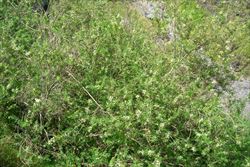
infestation (Photo: Forest and Kim Starr, USGS)
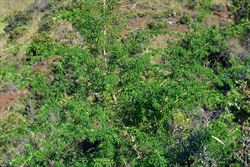
habit (Photo: Forest and Kim Starr, USGS)

habit in flower (Photo: Sheldon Navie)
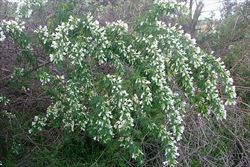
drooping branches (Photo: Sheldon Navie)
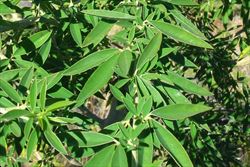
leaves (Photo: Forest and Kim Starr, USGS)

flower clusters (Photo: Sheldon Navie)
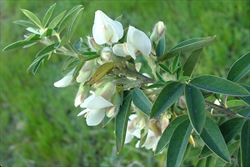
flowers in small clusters in the upper leaf forks (Photo: Sheldon Navie)

leaves, each with three leaflets, and flower cluster at the tip of a branch (Photo: Sheldon Navie)

pea-shaped flowers (Photo: Sheldon Navie)
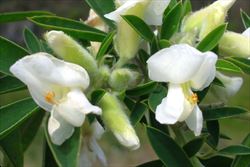
close-up of flowers with hairy sepals (Photo: Forest and Kim Starr, USGS)

immature fruit (Photo: Sheldon Navie)
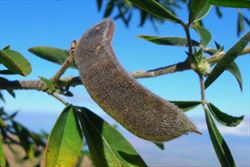
close-up of mature fruit (Photo: Forest and Kim Starr, USGS)

close-up of seed (Photo: Forest and Kim Starr, USGS)
Scientific Name
Chamaecytisus palmensis (Christ) Bisby & Nicholls
Synonyms
Chamaecytisus prolifer (L. f.) LinkChamaecytisus proliferus (L. f.) LinkChamaecytisus proliferus (L. f.) Link subsp. palmensis (Christ) KunkelChamaecytisus proliferus (L. f.) Link var. palmensis ChristCytisus palmensis (Christ) Hutch.Cytisus proliferus L. f.
Family
Fabaceae (Queensland, the ACT, Victoria, Tasmania and the Northern Territory)Fabaceae: sub-family Faboideae (New South Wales)Leguminosae (South Australia)Papilionaceae (Western Australia)
Common Names
silky cytisus, tagasaste, tree lucerne, tree-lucerne
Origin
Native to the Canary Islands in the Mediterranean region.
Cultivation
This species has been cultivated extensively as a fodder shrub and has sometimes also been used in land rehabilitation. It is also occasionally grown as a garden ornamental.
Naturalised Distribution
Widely naturalised in southern Australia. (i.e. in south-eastern Queensland, New South Wales, ACT, Victoria, Tasmania, south-eastern South Australia, and south-western and western Western Australia). Also sparingly naturalised on Norfolk Island.
Widely naturalised overseas, including in New Zealand.
Habitat
This species grows along roadsides, in pastures, grasslands, heathlands, open woodlands, disturbed sites and waste areas, along waterways and drainage lines, and around old habitations in temperate, semi-arid and occasionally also sub-tropical regions.
Habit
An upright (i.e. erect) shrub or small tree usually growing 1-4 m tall, but occasionally reaching up to 6 m in height.
Distinguishing Features
-
an upright shrub or small tree (1-6 m tall) with drooping branches.
-
its branches, leaf undersides, flower sepals and fruit are softly hairy.
-
its leaves (up to 7 cm long) are compound with three elongated leaflets (10-50 mm long and 4-16 mm wide).
-
its white or cream coloured pea-shaped flowers (14-17 mm long) are borne in small dense clusters.
-
its fruit are elongated and flattened pods (4-6 cm long and 8-12 mm wide) that turn brown or black when mature.
Stems and Leaves
Its branches are long, leafy and droop towards the ground (i.e. they are pendulous). The younger branches are softly hairy (i.e. pubescent) and olive green to greyish-brown in colour.
The leaves (up to 7 cm long) are compound with three leaflets (i.e. trifoliate) and are usually dull green or bluish-green in colour. They are alternately arranged along the stems and borne on stalks (i.e. petioles) 5-20 mm long. The leaflets (10-50 mm long and 4-16 mm wide) are elongated in shape (i.e. narrowly elliptic to rhombic) with entire margins. They have pointed tips (i.e. apiculate or acute apices), mostly hairless (i.e. glabrous) dark green upper surfaces, and softly hairy (i.e. pubescent) paler green undersides.
Flowers and Fruit
The pea-shaped flowers are borne in small dense clusters in the leaf forks or at the tips of short side branches (i.e. in terminal or axillary umbels). These flowers are scented and borne on stalks (i.e. pedicels) 7-22 mm long. Each flower has five green or reddish-tinged, hairy (i.e. pubescent), sepals (9-13 mm long), that are partially fused together at the base (i.e. into a calyx tube about 5 mm long), and five white or cream-coloured petals (14-17 mm long). The uppermost of these petals (i.e. the standard) is larger than the two side petals (i.e. wing or lateral petals). The two lower petals are fused together into what appears to be a single folded petal (i.e. the keel). Inside these petals are ten stamens, which are joined to each other at the base (i.e. coherent), and an elongated ovary topped with a style and small stigma. Flowering occurs mainly during late autumn, winter and spring (i.e. from April to October).
The fruit are elongated and flattened pods (4-6 cm long and 8-12 mm wide) that split open when fully mature (i.e. they are dehiscent). These fruit are covered in soft hairs (i.e. they are pubescent) and turn from green to brown or black in colour as they mature. Each pod contains about 5-10 hard seeds (about 5 mm long and 3 mm wide). The seeds are flattened (i.e. compressed), oval-shaped (i.e. elliptic), shiny in appearance, and brown or black in colour.
Reproduction and Dispersal
This species reproduces manily by seed, which are thought to be spread by ants, birds and slashing. They can also be dispersed short distances when they are explosively released from the mature fruit. They are dispersed longer distances by deliberate plantings, in dumped garden waste, by machinery, and in contaminated soil.
Environmental Impact
Tree lucerne (Chamaecytisus palmensis) is regarded as an environmental weed in New South Wales (particularly in central and southern regions), Victoria, South Australia, Western Australia and Tasmania. It is particularly invasive in the non-arid inland areas of south-eastern Australia and has become naturalised in almost all areas where it has been planted as a fodder plant. This species is actively managed by community groups in South Australia and Western Australia and is currently listed as a priority environmental weed in at least one Natural Resource Management region. Tree lucerne (Chamaecytisus palmensis) also appears on numerous local environmental weed lists in the Sydney and Blue Mountains region, throughout Victoria, in south-eastern South Australia and in Tasmania.
In south-western Western Australia it grows in disturbed natural vegetation on lateritic soils in higher rainfall areas it is a serious invader of disturbed bushland. In all regions where it is found, it readily invades roadsides, creek banks and other disturbed sites and spreads from these areas into native bushland and grasslands.
Tree lucerne (Chamaecytisus palmensis) accumulates large quantities of long-lived seeds in the soil seed bank and readily germinates after fire or other disturbance, forming dense infestations that can smother native vegetation and prevent regeneration. Its nitrogen-fixing ability also increases soil fertility, helping other weeds to colonise invaded sites and out-compete the native species.
Other Impacts
The seeds of this species are poisonous.
Legislation
Not declared or considered noxious by any state government authorities.
Management
For information on the management of this species see the following resource:
- Muyt (2001), Bush Invaders of South-east Australia, pp. 163-164.
Similar Species
Tree lucerne (Chamaecytisus palmensis) is very similar to white Spanish broom (Cytisus multiflorus) and the white weeping brooms (Retama monosperma and Retama raetam). These species can be distinguished by the following differences:
- tree lucerne (Chamaecytisus palmensis) has drooping branches and relatively large leaflets (10-50 mm long and 4-16 mm wide) with hairy (i.e. pubescent) undersides. Its relatively large and elongated fruit (4-6 cm long) are softly hairy (i.e. pubescent) and turn dark brown or black and split open when mature.
- white Spanish broom (Cytisus multiflorus) has upright branches and relatively small leaflets (up to 12 mm long and 4 mm wide) with hairy (i.e. pubescent) surfaces. Its relatively small elongated fruit (1.5-3 cm long) are softly hairy (i.e. pubescent) and turn dark brown or black and split open when mature.
- the white weeping brooms (Retama monosperma and Retama raetam) have drooping branches and very small leaflets (about 5 mm long and 1 mm wide) that are quickly shed. Their small fruit (1-1.5 cm long) are hairless (i.e. glabrous) and turn light brown and do not readily split open when mature.
It is also similar to many of the other brooms (e.g. Genista spp. and Cytisus spp.), however these other species can be easily distinguished by their yellow flowers.

